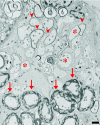Restoring the balance between disease and repair in multiple sclerosis: insights from mouse models
- PMID: 20647413
- PMCID: PMC2931531
- DOI: 10.1242/dmm.001958
Restoring the balance between disease and repair in multiple sclerosis: insights from mouse models
Abstract
Multiple sclerosis (MS) is considered an autoimmune-mediated demyelinating disease that targets the central nervous system (CNS). Despite considerable research efforts over multiple decades, our understanding of the basic biological processes that are targeted in the disease and the mechanisms of pathogenesis are poorly understood. Consequently, current therapies directed at controlling the progression of the disease are limited in their effectiveness. Historically, the primary focus of MS research has been to define the cellular and molecular basis of the immunological pathogenic mechanisms. Recently, however, it has become clear that long-term functional recovery in MS will require the development of strategies that facilitate myelin repair in lesion areas. The emerging evidence that the adult vertebrate CNS retains the capacity to regenerate neural cells that have been lost to disease or damage has provoked intensive research focused on defining the mechanisms of myelin repair. Unfortunately, the existing animal models of MS are poorly equipped to assess myelin repair, and new validated strategies to identify therapeutics targeted at promoting myelin repair are badly needed. This Commentary will review established murine models of MS, and discuss emerging technologies that promise to provide insights into the mechanisms of myelin repair.
Figures



References
-
- Arnett HA, Fancy SP, Alberta JA, Zhao C, Plant SR, Kaing S, Raine CS, Rowitch DH, Franklin RJ, Stiles CD. (2004). bHLH transcription factor Olig1 is required to repair demyelinated lesions in the CNS. Science 306, 2111–2115 - PubMed
-
- Bando Y, Takakusaki K, Ito S, Terayama R, Kashiwayanagi M, Yoshida S. (2008). Differential changes in axonal conduction following CNS demyelination in two mouse models. Eur J Neurosci. 28, 1731–1742 - PubMed
-
- Bansal R, Kumar M, Murray K, Morrison RS, Pfeiffer SE. (1996). Regulation of FGF receptors in the oligodendrocyte lineage. Mol Cell Neurosci. 7, 263–275 - PubMed
-
- Baxter AG. (2007). The origin and application of experimental autoimmune encephalomyelitis. Nat Rev Immunol. 7, 904–912 - PubMed
Publication types
MeSH terms
Grants and funding
LinkOut - more resources
Full Text Sources
Medical

